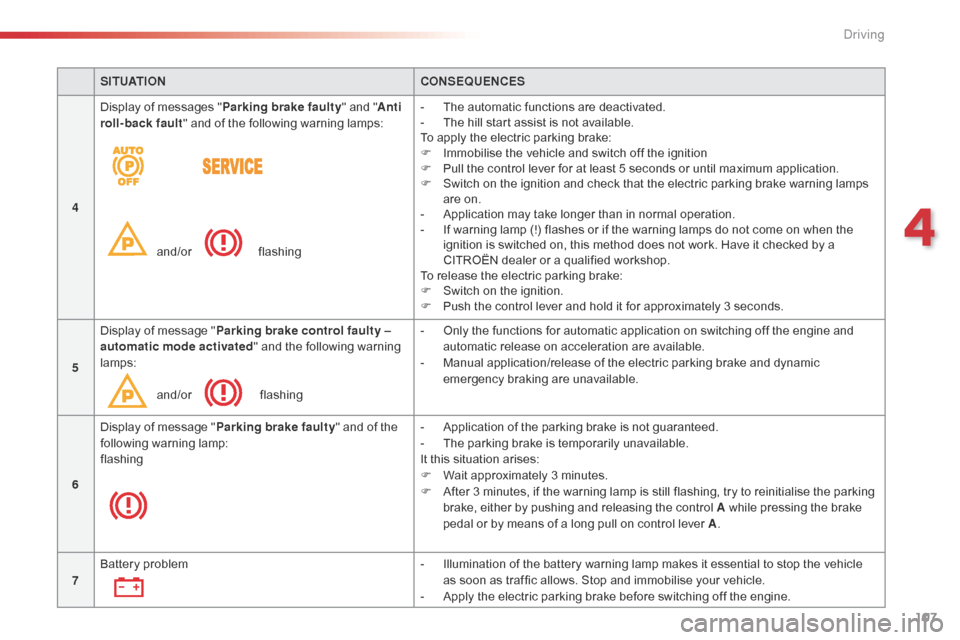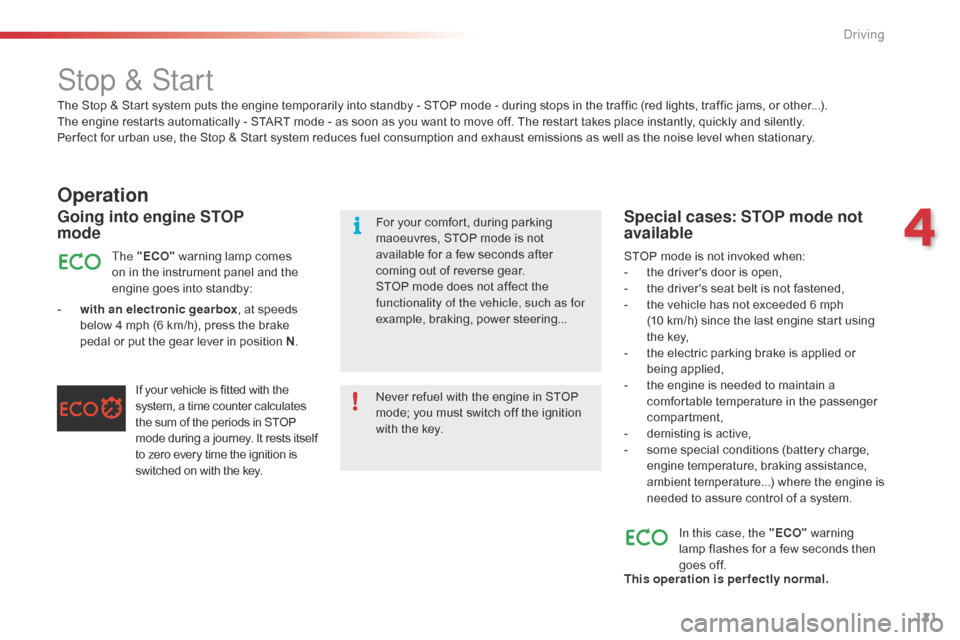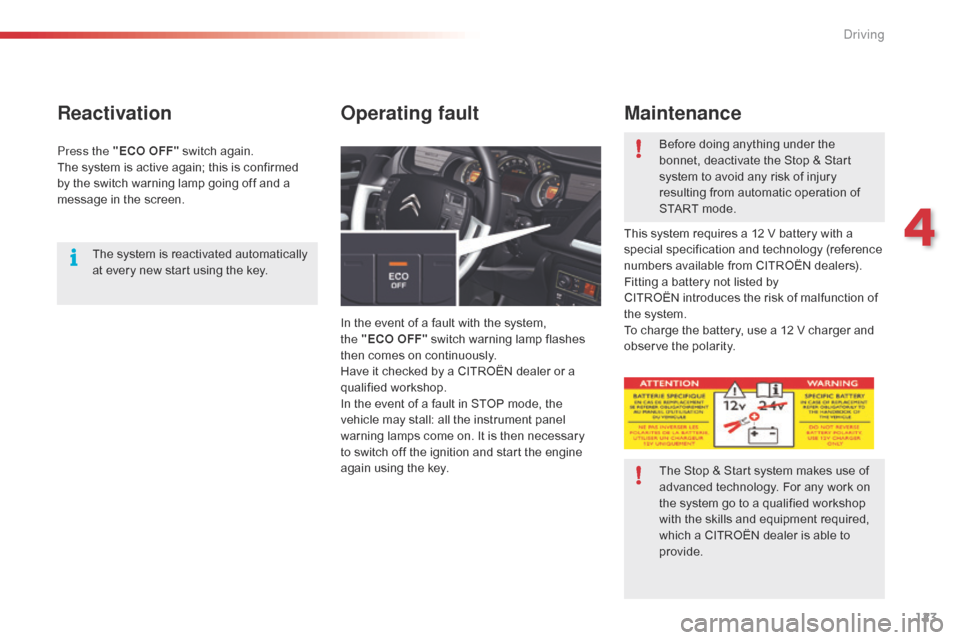STOP Citroen C5 2015 (RD/TD) / 2.G Owner's Guide
[x] Cancel search | Manufacturer: CITROEN, Model Year: 2015, Model line: C5, Model: Citroen C5 2015 (RD/TD) / 2.GPages: 344, PDF Size: 12.95 MB
Page 119 of 344

105
C5_en_Chap04_conduite_ed01-2014
If a failure of the DSC system is
signalled by the illumination of this
warning lamp, then braking stability is
not guaranteed. In this event, stability
must be assured by the driver by
repeating alternate "pull - release"
actions on control lever A.
The dynamic emergency braking
should only be used in exceptional
circumstances.
If it is not possible to immobilise the
vehicle, contact a CITROËN dealer or
a
qualified workshop.
Dynamic emergency
braking
In the event of a failure of the vehicle’s main
braking system or in an exceptional situation
(e.g. driver taken ill, under instruction, etc) pull
and hold control lever A to stop the vehicle.
The dynamic stability control system (DSC)
provides stability during dynamic emergency
braking.
If there is a fault with the dynamic emergency
braking, one of the following messages will be
displayed in the instrument panel screen:
-
"
Parking brake faulty".
-
"
Parking brake control faulty".
4
driving
Page 121 of 344

107
C5_en_Chap04_conduite_ed01-2014
SITUATIONCONSEQUENCES
4 Display of messages "
Parking brake faulty" and "Anti
roll-back fault" and of the following warning lamps:
and/or
f
lashing-
T
he automatic functions are deactivated.
-
T
he hill start assist is not available.
To apply the electric parking brake:
F
I
mmobilise the vehicle and switch off the ignition
F
P
ull the control lever for at least 5 seconds or until maximum application.
F
S
witch on the ignition and check that the electric parking brake warning lamps
are on.
-
A
pplication may take longer than in normal operation.
-
I
f warning lamp (!) flashes or if the warning lamps do not come on when the
ignition is switched on, this method does not work. Have it checked by a
CITROËN dealer or a qualified workshop.
To release the electric parking brake:
F
S
witch on the ignition.
F
P
ush the control lever and hold it for approximately 3 seconds.
5 Display of message "
Parking brake control faulty –
automatic mode activated " and the following warning
lamps:
and/or
f
lashing-
O
nly the functions for automatic application on switching off the engine and
automatic release on acceleration are available.
-
M
anual application/release of the electric parking brake and dynamic
emergency braking are unavailable.
6 Display of message "
Parking brake faulty " and of the
following warning lamp:
flashing -
A
pplication of the parking brake is not guaranteed.
-
T
he parking brake is temporarily unavailable.
It this situation arises:
F
W
ait approximately 3 minutes.
F
A
fter 3 minutes, if the warning lamp is still flashing, try to reinitialise the parking
brake, either by pushing and releasing the control A while pressing the brake
pedal or by means of a long pull on control lever A .
7 Battery problem
-
I
llumination of the battery warning lamp makes it essential to stop the vehicle
as soon as traffic allows. Stop and immobilise your vehicle.
-
A
pply the electric parking brake before switching off the engine.
4
Driving
Page 128 of 344

114
C5_en_Chap04_conduite_ed01-2014
SPORT programmeStopping the vehicle
F Wit the gear lever at A and the engine
running, press button S to activate
the
SPORT programme, which provides a
more dynamic driving style.
S appears in the instrument panel.
F
P
ress the S button again to switch it off.
S then disappears from the instrument panel
screen.
On sharp acceleration, the gearbox will
not change up unless the driver acts on
the gear lever or the steering mounted
paddles.
ne
ver select neutral N while the vehicle
is moving.
Only engage reverse gear R when the
vehicle is immobilised with the brake
pedal pressed.
When immobilising the vehicle, with
the engine running, you must place the
gear lever in neutral N.
Before carrying out any work in the
engine compartment, check that the
gear lever is in neutral N and that the
parking brake is applied.
Before switching off the engine, you can
choose to:
-
m
ove to position N to engage neutral,
-
l
eave the gear engaged; in this case, it will
not be possible to move the vehicle.
In both cases, you must apply the parking
brake to immobilise the vehicle.
Driving
Page 132 of 344

118
C5_en_Chap04_conduite_ed01-2014
Automatic operation
F Move the gear lever to position D. T
he gearbox constantly selects the
gear that is best suited to the following
parameters:
-
d
riving style,
-
ro
ad profile
-
v
ehicle load.
The gearbox operates without requiring any
intervention on your part.
For certain manoeuvres (for example
overtaking), you can obtain maximum
acceleration by pressing the accelerator pedal
hard down past the point of resistance, which
then produces an automatic change down to a
lower gear. When braking, the gearbox may change down
automatically in order to provide effective
engine braking.
If you lift your foot off the accelerator abruptly,
the gearbox will not engage a higher gear.
Manual operation
Position of the gear lever for manual gear
changing.
F
M
ove the gear lever to position M .
F
P
ush the gear lever towards the " +" sign to
change up a gear.
F
P
ull the gear lever towards the " -" sign to
change down a gear.
-
I
f the vehicle stops or reduces speed (for
example when approaching a stop sign),
the gearbox changes down automatically
to
first gear.
-
I
n sequential mode, it is not necessary
to release the accelerator during gear
changes.
-
A r
equest to change gear is accepted only
if the engine speed permits it.
-
T
he SPORT and SNOW modes do not
operate in sequential mode.
Driving
Page 135 of 344

121
C5_en_Chap04_conduite_ed01-2014
Stop & Start
Operation
- with an electronic gearbox, at speeds
below 4 mph (6 km/h), press the brake
pedal or put the gear lever in position N .
Going into engine STOP
mode
The "ECO" warning lamp comes
on in the instrument panel and the
engine goes into standby:
If your vehicle is fitted with the
system, a time counter calculates
the sum of the periods in STOP
mode during a journey. It rests itself
to zero every time the ignition is
switched on with the key.
Special cases: STOP mode not
available
In this case, the "ECO" warning
lamp flashes for a few seconds then
goes
off.
This operation is perfectly normal. STOP mode is not invoked when:
-
t
he driver's door is open,
-
t
he driver's seat belt is not fastened,
-
t
he vehicle has not exceeded 6 mph
(10 km/h) since the last engine start using
the key,
-
t
he electric parking brake is applied or
being applied,
-
t
he engine is needed to maintain a
comfortable temperature in the passenger
compartment,
-
d
emisting is active,
-
s
ome special conditions (battery charge,
engine temperature, braking assistance,
ambient temperature...) where the engine is
needed to assure control of a system.
The Stop & Start
system puts the engine temporarily into standby - STOP mode - during stops in the traffic (red lights, traffic jams, or other...).
The
engine restarts automatically - START mode - as soon as you want to move off. The restart takes place instantly, quickly and silently.
Per fect for urban use, the Stop & Start system reduces fuel consumption and exhaust emissions as well as the noise level when stationary.
Never refuel with the engine in STOP
mode; you must switch off the ignition
with the key. For your comfort, during parking
maoeuvres, STOP mode is not
available for a few seconds after
coming out of reverse gear.
STOP mode does not affect the
functionality of the vehicle, such as for
example, braking, power steering...
4
driving
Page 136 of 344

122
C5_en_Chap04_conduite_ed01-2014
- gear lever in position A or M, release the
brake pedal,
-
o
r gear lever in position N and the brake
pedal released, move the gear lever to
position A or M ,
-
o
r engage reverse gear.
Going into engine START
mode
The "ECO" warning lamp goes
off and the engine starts with an
electronic gearbox :
Special cases: START invoked
automatically
In this case the "ECO" warning
lamp flashes for a few seconds, then
goes
off.
This operation is perfectly normal. START mode is invoked automatically when:
-
t
he driver's door is open,
-
t
he driver's seat belt is not fastened,
-
t
he speed of the vehicle exceeds 7 mph
(11
km/h) with an electronic gearbox,
-
t
he electric parking brake is being applied,
-
s
ome special conditions (battery charge,
engine temperature, braking assistance,
ambient temperature...) where the engine is
needed for control of a system. At any time, press the "ECO OFF" switch to
deactivate the system.
This is confirmed by the switch warning lamp
coming on accompanied by a message in the
screen.
Deactivation
If the system has been deactivated
in STOP mode, the engine restarts
immediately.
Driving
Page 137 of 344

123
C5_en_Chap04_conduite_ed01-2014
Reactivation
In the event of a fault with the system,
the "ECO OFF" switch warning lamp flashes
then comes on continuously.
Have it checked by a CITROËN dealer or a
qualified workshop.
In the event of a fault in STOP mode, the
vehicle may stall: all the instrument panel
warning lamps come on. It is then necessary
to switch off the ignition and start the engine
again using the key.
Operating fault Maintenance
This system requires a 12 V battery with a
special specification and technology (reference
numbers available from CITROËN dealers).
Fitting a battery not listed by
CITROËN
introduces the risk of malfunction of
the system.
To charge the battery, use a 12 V charger and
observe the polarity. Before doing anything under the
bonnet, deactivate the Stop & Start
system to avoid any risk of injury
resulting from automatic operation of
START mode.
The Stop & Start system makes use of
advanced technology. For any work on
the system go to a qualified workshop
with the skills and equipment required,
which a CITROËN dealer is able to
provide.
The system is reactivated automatically
at every new start using the key.
Press the "ECO OFF" switch again.
The system is active again; this is confirmed
by the switch warning lamp going off and a
message in the screen.
4
Driving
Page 138 of 344

124
C5_en_Chap04_conduite_ed01-2014
Tyre under-inflation detection
System which automatically checks the
pressures of the tyres while driving.
The system continuously monitors the
pressures of the four tyres, as soon as the
vehicle is moving.The tyre under-inflation detection
system is an aid to driving which does
not replace the need for vigilance on
the part of the driver. This system does not avoid the need
to check the tyre pressures regularly
(including the spare wheel) and before
a long journey.
Driving with under-inflated tyres
adversely affects road holding,
extends braking distances and causes
premature tyre wear, particularly under
arduous conditions (vehicle loaded,
high speed, long journey).
The tyre pressures for your vehicle can
be found on the tyre pressure label (see
the "Identification markings" section).
The tyre pressures must be checked
when the tyres cold (vehicle stopped
for 1 hour or after driving for less then
6 miles (10 km) at moderate speed).
Other wise, add 0.3 bar to the values
indicated on the label.
Driving with under-inflated tyres
increases fuel consumption.
A pressure sensor is located in the valve of
each tyre (except the spare wheel).
The system triggers an alert if a drop in
pressure is detected in one or more tyres.
driving
Page 144 of 344

130
C5_en_Chap04_conduite_ed01-2014
The accelerator pedal has an end-of-travel
switch. In order to exceed the memorised
maximum speed at any time, you can press
the pedal all the way down. While the speed
is being exceeded, the speed displayed in
zone A will flash. You have only to release the
accelerator pedal to return below the maximum
speed, to restore the function.
Return to normal driving
F Either press on button 5.
F O r select the speed limiter function.
F
O
r stop the engine.
Operating fault
If there is a fault, a message is displayed
accompanied by an audible signal and
illumination of the SERVICE warning lamp.
Have it checked by a CITROËN dealer or a
qualified workshop.
Overriding the programmed
speed
In the event of a steep descent or
under excessive acceleration, the
speed limiter (which does not act
on the brakes) may not be able to
prevent the vehicle from exceeding the
programmed speed.
Use of a floor mat other than that
recommended by CITROËN may affect
the normal operation of the accelerator
pedal and hamper the operation of the
speed limiter.
Floor mats approved by CITROËN
are fitted with a 3rd fixing located in
the pedal area to avoid any risk of
inter ference with the pedals.
The speed will also flash if the speed limiter is
not able to prevent the vehicle from exceeding
the programmed speed (e.g. on a steep
descent or under excessive acceleration).
To reactivate the speed limiter, release the
accelerator to slow to a speed lower than the
programmed speed.
Driving
Page 147 of 344

133
C5_en_Chap04_conduite_ed01-2014
Reactivation
- By recalling the memorised speed After deactivation, press button 3. Your
vehicle automatically returns to the
memorised cruising speed. The memorised
speed and " ON" are displayed in zone A .
I
f the memorised cruising speed is higher
than the current speed, the vehicle will
accelerate strongly to reach the current
speed.
-
B
y selecting the current speed
P
ress button 1 or 2 once the desired speed
has been reached.
T
he new speed and " ON" will appear in
zone A .
Return to normal driving
F Either press on button 5 .
F O r select the cruise control function.
F
O
r stop the engine.
The speed that was chosen is no longer
memorised.
" PAUS E "
will be displayed in zone A of the
instrument panel.
These actions do not cancel the cruising speed
which remains displayed on the instrument
panel.
Operating fault
If there is a fault, a message is displayed
accompanied by an audible signal and
illumination of the SERVICE warning lamp.
Have it checked by a CITROËN dealer or a
qualified workshop.
Cruise control must only be used where
the traffic conditions permit driving at a
constant speed.
Do not use it on congested roads or
when the weather or the road conditions
are poor.
The driver must remain attentive and in
complete control of the vehicle.
You are recommended to keep your feet
within range of the pedals.
Suspension / Resumption
F Either by pressing the brake pedal or the clutch pedal.
F
O
r by pressing button 3 .
F
O
r by the DSC or ASR systems being
active.
For vehicles with a manual gearbox, cruise
control is deactivated if the gear lever is in
neutral.
4
Driving